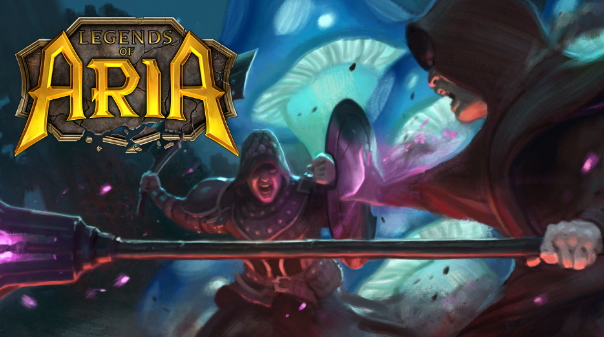Legends of Aria Early Access Review

Legends of Aria is an open-world, grind-oriented sandbox game where you can play however you want. It resembles Ultima Online, with one of the things I hated the most about the game removed: fear. In Ultima Online, you can be murdered at any time. It seems like that’s one of the big complaints about Legends of Aria right now, which says more about the people that play these games than the game itself. PVP has been restricted in Legends of Aria, and there are places where killing and acts of violence will not be tolerated. Some people are into that challenge, and that’s where the community servers come in. Legends of Aria is supposed to fully support Community Servers and Modding, so with that in mind, I’m sure someone will set up a lawless hellscape of griefing somewhere. This is a world that players shape and build, so why make it a miserable time?
Character Creation:
The world of Legends of Aria is vast and empty when you first start, other than clumps of players idling in towns. The wilderness is wide, and other than critters and bandits, there isn’t much out there. That’s to allow for plenty of players to be able to place a house, but we’ll get to that in due course. When you begin this adventure, you choose a server and design your avatar. The customization is fairly sparse, but you do get a fair amount of outfits to choose from before you move on. Whether you want to look like a beggar or a merchant, you can get the clothes that suit you. There are a few archetypes to choose from in terms of character build, and each has its own starting skills. Your archetype choices are Warrior, Mage, Archer, Bard, Blacksmith, and Advanced. Advanced lets you set things up however you like, without much in the way of restrictions. While the archetypes do have starting skill points, you can adjust those points, as long as they don’t go over 100 total points. I like the idea of my character not being able to master everything in a sandbox. You figure out what you want to do, and then you set out learning and improving those skills by repetitively doing related tasks. Do you want to be a blacksmith? Then you fail at creating Chain Hoods and Cookpots for a few days.
It really does have that old-school UO feel, where you master things simply by doing them until you get it right. Then you’ll gain +0.1/+0.3 of a point and keep doing that thing. When I said you can’t master everything though, I meant it. Character stats have a total cap of 150, and skill points have a cap of 600. If you want, you can lock stats so they don’t go up, or can even set them to lower. Skills have a sliding bar that lets you set a cap, so you don’t accidentally overlevel them. You can also use that to build however you like. Legends of Aria will not hold your hand or guide you through the game, so doing research on their wiki or asking questions is key. There is one concession: when you’re training professions, many of the quests your teacher gives you will include a map marker. Now that you’ve made a character, it’s key to know that while there are classes among the professions (Mage, Rogue, Fighter, Tamer, Bard), you can still defeat monsters and wildlife without them. I would definitely look at the professions to see which are most interesting to you, as each has a set of skill requirements.
Gameplay:
At first, I balked when I saw Bard. I asked myself “How could that even be relevant in a world where you mostly go around killing and crafting?”, but that answer was quickly handed to me. Players have a “Vitality” stat that starts at Well Rested and goes down the more you do stuff in the world. If there are Bards nearby, you can listen to their music, and it will restore your vitality after spending a bit of time with them. This makes Bards an indispensable part of any community, and I’ve seen them pop-up in a variety of places. Every profession has a use, whether you’re a Chef, Tailor, Carpenter, or Animal Tamer. I’ve seen so many Animal Tamers out in the world fighting with small armies of bears, horses, and even with giant blue dragons.
The starting hours of a game like this can feel very tedious and plodding, and Legends of Aria was no exception. I started a character on a server, going for the mage route. Mages, as I’ve read, can be very powerful. I did not enjoy the early game life of a Mage and went to be a Fighter/Blacksmith instead. This way I could take a hit, have a higher carrying limit, and not have to fuss with nonsense like spells, tomes, and ingredients. It was just me, a pile of various ores, and a gigantic axe made of gold. Eventually.
I still had to spend several days grinding through mining and smithing, so I could repeatedly fail to make even the simplest of gear. In fact, I did not make a full set of gear until around hour 30. Before that, I wore the starting leather I was given at the beginning of the game. It felt incredible to finally start succeeding more at crafting. I would go into a crafting session with about 200 bars of Iron/Copper, making gear that only requires 2-3 bars and leaves with 3-5 pieces of gear total. The reasons for spamming the crafting are twofold: first, to hopefully skill-up; and second, so I could complete Crafting Orders. That’s the easiest way I’ve found to make money, other than killing certain enemies for small amounts of gold or completing Bounties. Crafting Orders would net me about 2k gold a run, cost me nothing up-front, and occasionally gave me runes to equip or new recipes to practice on. To find what Crafting Orders need to be filled, simply go to the proper trainer/crafter (Blacksmith, Tailor, et cetera) and interact with them. There will be a discussion topic on crafting orders. You can only complete one per half-hour, but I’ve only had one done that quickly once or twice.

There's a nice big world out there. Thankfully, teleporters make getting where you want to go faster.
That’s something I definitely appreciated: I wasn’t just making armor to make it and then do nothing with it. I didn’t have a storefront, so in theory, it’s going back into this community of NPCs, who will, by my storytelling standards, go off to fight and die to bandits somewhere bearing the gear I made for them. Much of my time in the game was spent in this process. The world is vast, and ore is everywhere. Just look for clumps of rock with colored veins in them. There are quite a few landmarks to find, if you just wander (or if you Google the map found on their Wiki). I stumbled upon a mine that was always rich with whatever minerals I presently happened to need. It was a bit far away, so I bought a horse to cut down that travel time. 500g is a worthwhile investment for faster movement. While Legends of Aria is challenging, I have not once found it cruel or unfair.
Taking the time out of your crafting and skill leveling to wander the world can be rewarding. You can find other players selling powerful items at reasonable prices. There are dungeons to seek out, graveyards filled with undead, bandits to slaughter, and adorable animals to fight for you. If you want to find some of these areas faster, there are Gateways/Gatekeepers who can teleport you across the world, free of charge. Gates are marked on the map, but they don’t all take you to the same place – you’ll have to find out where each gate leads. I like that players can lock down their wares and set them out for purchase, typically at their homestead. I do wonder if a Rogue can steal any of this stuff, but I haven’t leveled one enough to check. That would be interesting. As for housing: it is definitely expensive. The cheapest house is 5 Platinum, 6,000 Gold, and also has a weekly tax paid to the bank. However, you can only have one plot of land, and it’s shared across your characters on that server. 1 Platinum, as a note, is 10,000 gold. It takes time, but it possible to farm up.
Combat and Complaints:
Combat’s not so bad, but it is a little on the slow side. To get ready to fight, you hit Space Bar to draw your weapon and left-click the thing you want to fight. Each weapon has a pair of skills attached to it, but as you grow in the professions, you can train more of them. The melee abilities, for example, will activate on your next swing, so if you want to open with them, you’ll activate the ability, then walk into range. Overall, combat is fairly easy to learn, but be aware many combat skills have a stamina cost and can’t be spammed. Enemy AI is a bit on the weird side for some animals. Bears, for example, sometimes will ignore when other bears are fighting you. Then the next moment, a bear will run in, swipe at you, then leave. Then another bear will drive-by you. It’s very perplexing.
On the left side of your screen are keybound slots. You can slot potions, weapons, or whatever you need here. This makes it easy to swap from a mining pick to a great axe. Certain types of enemies can only be harvested for meat and fur (bears, wolves), but others can be harvested for sacks of money, potions, and treasure maps (bandits, giant rats). Take a little time to get to know the wildlife, and learn what may be useful for you to murder.
The longer I’ve played Legends of Aria, the more I’ve enjoyed the peaceful exploration and honing of my skills. This isn’t a perfect game by any stretch, because there are some bugs I’ve found that should have already been dealt with. The most important one is walking. That’s right, walking and horse riding are bugged in a way that I absolutely cannot fathom. When you’re walking on a flat, grassy area, everything is fine, you walk at your normal pace. But the instant the style of ground you’re on changes, you run the serious risk of slowing to a crawl. If the grass has high bushes, or rocks on it, you might get slowed. It’s even worse if you walk near any kind of wall or architecture. Near a fence? Slowed! Trying to get close to rocks to mine them? Slowed again! Trying to enter a building and walking up the steps? You guessed it. It’s very finicky though.
It seems to occur less while on a horse, at least. You can see some of this in the video above. It has made simply traveling to and from areas a frustrating chore. Thankfully, I have a hearthstone that will teleport me back to my hometown, and there’s a nearby teleporter that will take me to two other areas. The problem with the hearthstone is that occasionally it says you teleported safely, but you remain stuck where you are. If you hit ESC and hit “Stuck”, it will properly teleport you to town, but at first, I did not know this. Other than these two major issues, simply exploring has been enjoyable. The world is pretty and has that early 2000s Ultima feel that I cannot help but get lost in.
No Story for Old Men:
This game has no Main Story Quest, because it’s a sandbox. That’s not altogether uncommon, but I do prefer a bit of story with my sandboxing. There are plenty of NPCs who will fill you in on the world, as well as their personal backstories and problems. This dialogue becomes quickly repetitive with the NPCs you meet. Lots of people need to borrow money for milk, evidently. There are quests you can undertake to improve your Professions, but it’s not always clear when you can do them. They are typically available when you increase your talent in a craft (Journeyman, et cetera), so check back with your trainers often. There’s also the Dispatcher, who can send you out to quell various uprisings of animals or brigands. This is another valuable source of rewards and lets you help this land out. There are also guilds to join, but no UI to seek out a guild, nor private messages to whisper about if they are recruiting. There’s no privacy: just blurt it out in the open, or send a friend request. In this kind of game, you make your own story, and as long as you’re finding your own fun in the world, that’s all that matters. I imagine the community servers might create their own backstories and quests, since, with the right programming and server knowledge, you too can run your own world. There are people that say, thanks to unwelcome changes in the early access, alpha, and beta phases, the only “real” way to play is through the community servers, but I don’t necessarily agree. If you like where the game is, then just play wherever you’re comfortable.
An Open (But Sort of Empty) World: 3/5 (Good)
I’m normally not the biggest fan of sandbox games, but I’ve sort of grown attached to this character I’ve created. At first, I was frustrated and grumpy because nothing was going right, but now that I’ve made progress? My opinion has softened a bit. There are plenty of things to see and do in this world, from dungeons and bosses to epic gear to acquire (whether bought, made or found). I appreciate that you cannot do everything on one character and that you really have to carefully consider what path you walk, as far as stats/skills. You can change your mind and start working on other things, but it might be easier to just make a secondary character.
One thing I love is that the banks are all attached to each other, like a modern MMO. I went halfway across the continent, seeking a fine steed worthy of my gold-clad warrior, and realized I left all 9,000 GP back in the bank. When exploring, I never take money. I found that the town banks were connected, so if I decide to make one of these other towns my home, I can do that with ease. I wonder if players will have the power to construct their own banks, crafting areas, and dispatchers. Now that would be something to see: Players who act as the training NPCs once they hit grandmaster, and would have the power to teach younger/newer players where to go and how to improve. I don’t know if that’s on the docket, but it would suit this world well, with enough players.
Legends of Aria does not shatter many barriers as an open sandbox MMO, but for fans of the genre, the price tag of 30 bucks is not unreasonable. There are always new ways to play, community servers to explore, and friends to make. There are still improvements to be made, but I enjoyed my time in this world, and may just find myself back in it again to continue my growth as a warrior-smith. I spent most of my time in Legends of Aria playing alone, though I would have more fun playing with a group of people. This style of game serves the idea of players coming together and forming a community well.
There’s a “Loyalty Shop”, which provides exclusive items that cannot be bought with real money. Loyalty Points come from bug finding, referrals, and participating in events. This is fine, and none of these rewards are game-breaking. They’re pretty neat. I’ve read a lot on the Internet about the game being pay-to-win in the earlier part of this year, but this seems to be addressed. The closest to a “pay-to-win” item on the Loyalty Shop is the Soulstone, which can hold up to 100 points of a skill. It can only be retrieved on the account that created it, though. At best, it’s a way to get a new character started a bit faster. I’m glad they walked back the “Power House Potions” that were available earlier in the game’s development cycle. I have been told there will be a subscription offer and cosmetic items, such as outfits. I just hope it won’t have some kind of pay-to-win shenanigans in it. Monetization makes sense as an MMO. You simply cannot continue to run an MMO without a way to monetize the game. Legends of Aria has a lot to offer fans of the sandbox genre, and should it continue to grow, and offer fair monetization, I can see it having a nice, long life.
Legends of Aria Screenshots
Articles You May Enjoy
- Sony Online Entertainment Halloween Events Announced
- Sony Online Entertainment released details on their Halloween events for Bullet Run, DC Universe Online, Everquest, Everquest II, Free Realms,...
- New Rogue and Scout skills revealed for The Repopulation
- The Repopulation team is revealing many different skills and abilities that will be available for all Rouge and Scout users.
- Elsword Takes Ara Haan to the Next Level with New Sakra Devanam Class
- News from Kill3rCombo about the release of Elsword's second job class for Ara Haan.































































